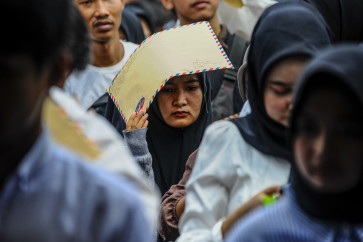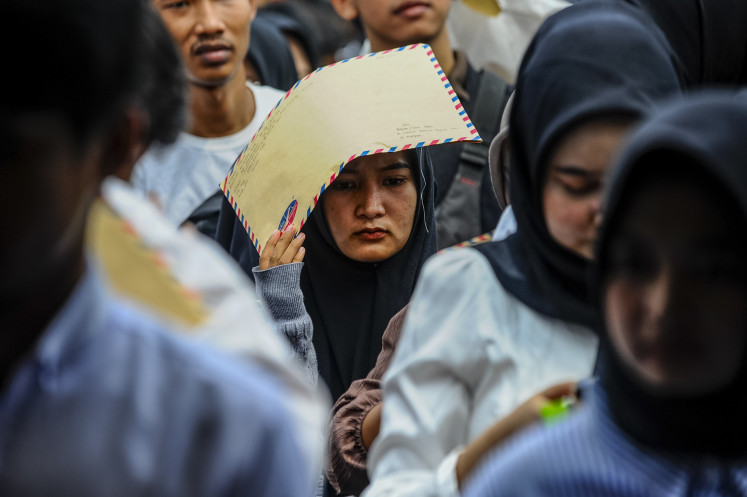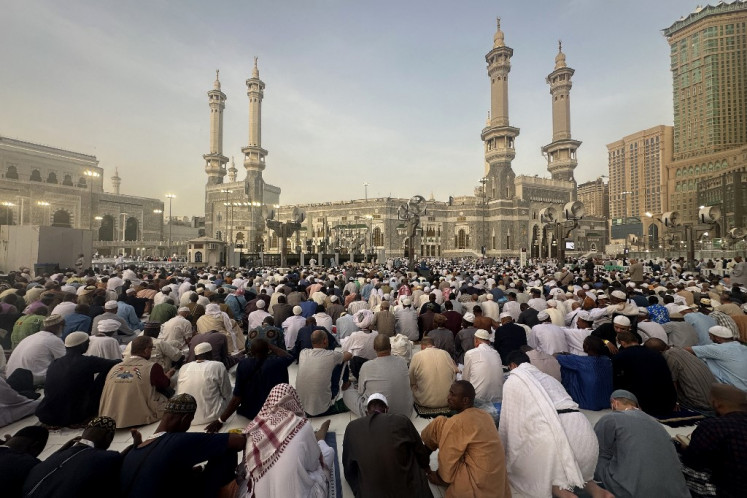Refashioned stadium rekindles spirit
The world-class Gelora Bung Karno sports complex, a legacy of Indonesia’s founding father Sukarno, has been renovated for the upcoming Asian Games, which will be cohosted by Jakarta and Palembang, South Sumatra
Change text size
Gift Premium Articles
to Anyone

The world-class Gelora Bung Karno sports complex, a legacy of Indonesia’s founding father Sukarno, has been renovated for the upcoming Asian Games, which will be cohosted by Jakarta and Palembang, South Sumatra. The Jakarta Post sports correspondent Ramadani Saputra has taken a look at the history of the sports complex, from its inauguration to what it looks like today after having gone through a US$205 million renovation.
In many parts of the world, sports stadiums signify the greatness of a country. Spain boasts Camp Nou. Built in the 1950s to seat 99,000, it is Europe’s largest stadium. China has the 80,000-seat Beijing National Stadium, also known as the Bird’s Nest for its unique design.
As the largest nation in Southeast Asia, Indonesia is proud to have the newly revamped Gelora Bung Karno sports complex. Its main stadium has a capacity of 76,000 (formerly 88,000). AS Roma, PSV Eindhoven, Manchester United, Arsenal, AC Milan and Bayern Munich are some of the world’s biggest clubs that have played at the stadium throughout the decades.
Located at the prime site of Senayan, Central Jakarta, the 120-hectare sports facility was built in the 1960s when Indonesia had the honor of playing host to the fourth edition of the multisport Asian Games in 1962, which involved 17 nations. The prestigious Games are held every four years.
It was a testament to Indonesia’s first president Sukarno, who was known for launching megaprojects. As the story goes, the idea of building a gigantic sporting complex came out of his ire at the rest of the world, which doubted young Indonesia’s ability to have a world-class stadium.
The history of the sports complex is discussed in a classic book entitled Dari Gelora Bung Karno ke Gelora Bung Karno by Kompas journalist Julius Pour.
Bung Karno, as the president was famously called, was so proud of the stadium that he named it Gelora Bung Karno — a semantic play of the Indonesian word gelora (passion).
In the book, Julius recalls a story by “the great orator” Sukarno about inaugurating the gigantic facility, which had a maiden capacity of 110,000, in July 1962.
“I have traveled the world,” he told a cheering audience. “I have seen stadiums in Rio de Janeiro, Warsaw and Mexico and I have found the Jakarta stadium to be the best in the world.”
The project was partly funded with a $12.5 million loan from the Soviet Union, one of Indonesia’s closest allies at that time, following Sukarno’s visit to the communist country and meeting with Nikita Khrushchev in 1956. Russian architects were involved in the design of the stadium, so it is no wonder that it resembles the national stadium of Russia, Moscow’s Luzhniki Stadium.

What’s in a name
In biography Bung Karno: Penyambung Lidah Rakyat Indonesia (Bung Karno: The Voice of the Indonesian People) by Cindy Adams, Sukarno was said to have addressed his critics, who accused him of wasting taxpayers’ money on the stadium. He argued that the splurge was for the nation’s glory, not for his fame.
The inauguration ceremony was historic as it coincided with that of state-owned TVRI, Indonesia’s first television network, which is located near the stadium.
Senayan was picked as the monumental project’s site following a heated debate, which ended after Sukarno and Indonesian architect Friedrich Silaban worked together to survey the capital for the most suitable site on a presidential helicopter.
From the outset, Sukarno had wanted Dukuh Atas, also in Central Jakarta, to be the location for the complex, according to Julius. But Silaban opposed the president’s idea, arguing that Duku Atas was too close to the city center, prone to flooding and that the facility would cause traffic congestion.
Silaban, one of the country’s best-known architects then, designed the capital’s iconic Istiqlal Mosque and the National Monument (Monas). He managed to convince Sukarno that Senayan would be the best site. Then, the approximately 300-hectare area was home to farmland and a residential quarter full of tall trees.
A year after hosting the 1962 Asian Games, Gelora Bung Karno made history when it hosted the first-ever New Emerging Forces Games (Ganefo), which saw athletes from 51 nations compete.
Ganefo was Indonesia’s response to the International Olympic Committee’s (IOC) censure for not allowing Taiwan and Israel to participate in the 1962 Games. The IOC later terminated Indonesia’s membership over the controversy. It readmitted Indonesia in 1964.
President Soeharto, Sukarno’s successor, renamed Gelora Bung Karno to Senayan Sports Complex in 1969. The stadium eventually regained its original name during Abdurrahman Wahid’s presidency in 2001.
Senayan fast developed into an urban center. Much of the property under the State Secretariat has been lost to the development of hotels, upscale shopping malls, government offices, parliament buildings, restaurants, roads and other business venues.

Put to the test
This year, Jakarta has the honor again to host the Asian Games alongside Palembang, the provincial capital of South Sumatra. Vice President Jusuf Kalla said the Games would cost about Rp 30 trillion (US$2.2 billion), with most of the funds being allocated for infrastructure construction and renovation.
Indonesia seized the opportunity to host the Games after Vietnam withdrew due to financial difficulties. With just four years to prepare, Indonesia has faced a slew of problems, including delays to the Gelora Bung Karno renovation because of a lack of foreign financial assistance.
The Public Works and Housing Ministry started the restoration project in 2016. The stadium’s heritage site status means that it must retain its original form and so only essential modifications were allowed.
A Rp 2.8 trillion revamp focused on the main stadium, three soccer fields, the aquatics arena, indoor and outdoor tennis courts and the Istora indoor stadium. The main stadium is the venue for soccer, track and field, archery and field hockey competitions.
All of the aforementioned venues are ready for use and were inaugurated by President Joko “Jokowi” Widodo between December 2017 and February 2018. Several sporting events have been held to test the venues.
The aquatics center, for example, hosted an official test event from Dec. 5 to 9, 2017, shortly after its inauguration. Called the 2017 CIMB Niaga Indonesia Open Aquatic Championship, the event featured 1,500 athletes from Indonesia, India, Malaysia, the Philippines, Thailand and Vietnam.
Unlike before, the aquatics venue now has a roof. A Rp 274 billion renovation redesigned the roof to remain half-open to prevent corrosion resulting from chlorine vapor from the venue’s four pools.
In January, the Istora indoor stadium housed the 2018 Daihatsu Indonesia Masters badminton tournament, the first event held after the renovation. The world’s top shuttlers, including world number one Viktor Axelsen of Denmark, took part in the
championship.
“The major renovation was done without changing its [original] look. We hope it [Istora] can be used for other sporting events,” Jokowi said when inaugurating the 7,166-capacity venue on Jan. 24.
Also in January, the main stadium hosted its first match after a Rp 769 billion renovation, presenting a friendly between Indonesia and Iceland, a 2018 FIFA World Cup contender.
Its capacity has been reduced to 76,152 from 88,083, while its lighting and sound systems were upgraded. The stadium glows during night events, with a lighting capacity of 3,500 lux — about three times brighter than the previous 1,200 lux.
Sri Hartoyo, director general of the Public Works and Housing Ministry, said the eco-friendly electricity system was supported by a 4,000-kilowatt solar panel.
However, soccer hooligans vandalized the newly renovated stadium shortly after Persija Jakarta won the President’s Cup on Feb. 17. Their actions cost the management about Rp 150 million.
The 2018 Indonesian Asian Games Organizing Committee (INASGOC) also held a week-long official test event, the 18th Asian Games Invitational, which featured nine countries, in February.
Facilities that remain under renovation are the Madya stadium — a secondary track-and-field facility — baseball and softball fields, training centers and a basketball court.
After 54 years, the Gelora Bung Karno sports complex will be the venue for Indonesia to reimagine its pride. Were Sukarno still here, he would probably still admire the newly renovated complex, if not shed a few tears for the shrinking space.









